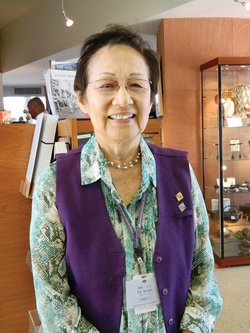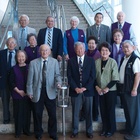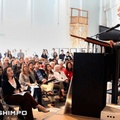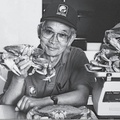Of all the Japanese-speaking docents at the Japanese American National Museum today, Yae Kanogawa Aihara is the last and only Nisei of the group who experienced the concentration camps during WWII. The rest were born and grew up in Japan, or Kibei who learned the language while growing up there. Yae started to learn her Japanese as a child and continued to learn it in Texas during WWII.
Born in Tacoma, Washington, Yae was 16 when the war began. Her father, Sho Kanogawa, was from Wakayama and ran a grocery store. He was actively involved in Seattle’s Nikkei community primarily as president of the Wakayama Kenjinkai. He also served as an advisor for a judo dojo and one of the board members of the Japanese Chamber of Commerce.
On the evening of the bombing of Pearl Harbor, Sho was arrested by the FBI and eventually detained in New Mexico. The rest of the family was sent without him to the Puyallup Assembly Center, which had been hastily built on former fairgrounds.
“It was rough construction,” Yae recalls. The wood was not treated, and after drying, it shrank, creating gaps between the boards. “It was humiliating,” she says, because the restrooms had no walls or curtains, and six people could use the same space at the same time.
After three months, the family was sent to a concentration camp in Minidoka, Idaho. When the canteen opened, she went there almost every day and shared a one-quart box of ice cream with a friend, which led her to gain a lot of weight. Held in Minidoka for about a year, the family was told that if they would agree to repatriate, they would be released from camp and reunited with their father.
The family met Sho in New York, where they planned to board a ship to Japan. However, there was no space for the Kanogawa family. More than 30 years later, Yae learned that that particular vessel had been an exchange ship for prisoners of war. Japan had captured many American soldiers during the Pacific War, but Japanese soldiers often fought to the death. America needed Japanese prisoners to exchange for the American POWs, so the U.S. government arranged for about 2,000 Japanese Peruvian to be brought to the U.S. Of those, 700 were on the ship that Yae and her family had planned to board.
The exchange ship met its Japanese counterpart in Goa and traded prisoners. However, some of the Japanese prisoners were not taken back to Japan due to their physical condition. Instead, they were taken to Siberia where they became forced laborers. She was horrified when she found out about it because her brothers might have been taken to Siberia if they were on that ship.
After being denied boarding, Yae’s family could not go back to Minidoka because of her father’s status. To keep the family together, they were sent to the Department of Justice camp in Crystal City, Texas. The camp was full of Spanish-speaking Japanese Peruvian. Yae wondered why there were so many Japanese Peruvian there.
The Crystal City camp had many Japanese language teachers who were all Buddhist priests. Yae attended Japanese school every day. After the war, every person in the camp received $25 and a one-way train ticket, and started their life over. The Kanogawas left Crystal City and came to Los Angeles to look for work.
Since she was a child, Yae heard Japanese words from her Issei parents like “gaman shinasai (must do it), shikata ga nai, and mottainai (wasteful).” The most frequently-heard phrase was “Shikata-ga-nai, nihonjin dakara”—meaning “Nothing can be done; it’s because we are Japanese.”
Before the war, Japanese could not be naturalized nor could they own land. No Japanese American could become a teacher. But the Nisei helped each other to develop the Nikkei community and to improve their lives by working together.
For many years, Yae never spoke to anybody about her family’s incarceration during WWII. She was ashamed about this part of her past and never felt comfortable sharing her experiences.
Then one day, her son Doug began asking questions about her years in camp. He was studying the history of Japanese Americans for his social science class at UCLA. Since then, Yae decided that those stories had to be told and passed on to the next generation.
Doug’s questions were the impetus for Yae to begin volunteering at JANM after she retired. The Japanese skills she honed in Crystal City have been extremely useful, and she hopes that by sharing her family’s story, she can help prevent history from repeating itself.
* Yae Aihara was interviewed by Alice Hama and the article was written by Ryoko Onishi for Voices of the Volunteers: Building Blocks of the Japanese American National Museum, a book presented by Nitto Tire and published by The Rafu Shimpo. This story has been modified slightly from the original.

Presented by
© 2015 The Rafu Shimpo









